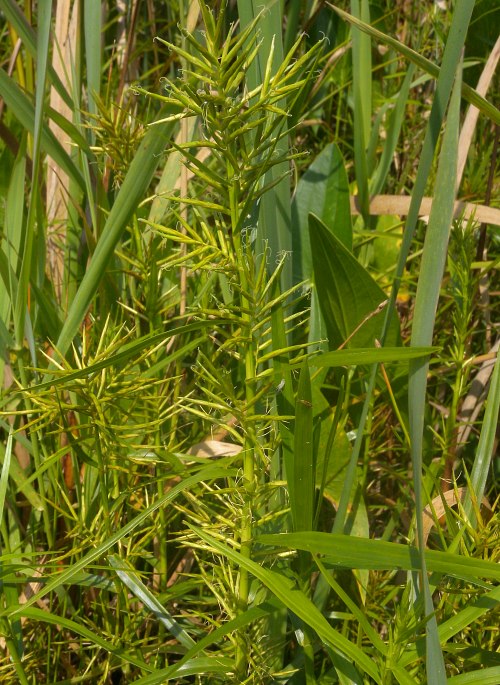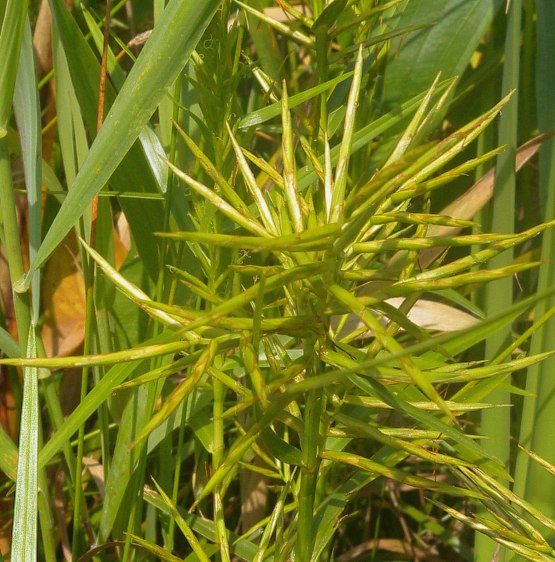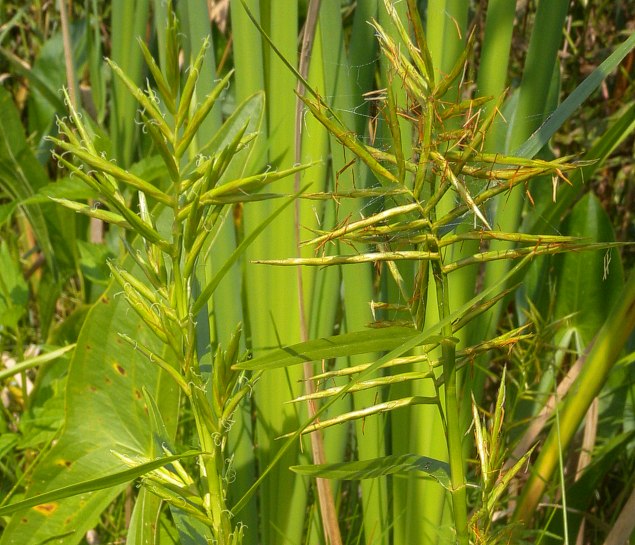
Each spikelet is ¾–1¼" (2-3 cm.) long, consisting of 4-9 perfect florets and their scales. Each floret has 3 stamens and an ovary with a single white style; the style divides into 2 narrow white stigmas at its tip. The anthers of the stamens droop down conspicuously from slender filaments. Depending on their maturity, the anthers are pale yellow to brown; they are 2-3 mm. long and linear in shape. The scales of the spikelets are 5-8 mm. long, narrowly oblong-lanceolate in shape, and tightly appressed; they have membranous-brown margins. The blooming period occurs during mid-summer to late summer, lasting about 2-3 weeks for a colony of plants; the florets are cross-pollinated by the wind. During late summer to early autumn, the spikelets become mature, and their scales with achenes begin to disarticulate individually. Mature achenes are 2.5–3.5 mm. long (excluding their persistent styles), narrowly oblongoid-ellipsoid in shape, somewhat flattened, and light tan to light brown. The persistent styles of the achenes are about the same length as the achenes. Each achene also has 6-9 barbed bristles that originate from its base, surrounding it on all sides; these bristles are 1-2 times the length of the achene. The root system is fibrous and slender-rhizomatous. Clonal colonies of plants often develop from the rhizomes.

Cultivation: The preference is full or partial sun, wet ground or shallow water (up to 6" deep), and a substrate containing abundant organic matter. This sedge also grows on sandy muck. It prefers a cool moist climate, although there are southern ecotypes of this sedge that tolerate more heat if they receive some shade.
Range & Habitat: The native Three-way Sedge (Dulichium arundinaceum) is uncommon in NE Illinois, while in the rest of the state it is rare or absent (see Distribution Map). It is found primarily in the Great Lakes region, northeastern USA, and adjacent areas of Canada, however it also occurs more sporadically in southeastern USA and the Pacific Northwest. At one time, during earlier interglacial periods, this distinctive sedge also occurred in Great Britain, France, and other areas of Europe, but it has since become extinct there (Bell, 1970; Andrieu et al., 1997). Habitats consist of various wetlands, including swamps and bottomland woodlands (southern Illinois), shallow marshes, fens, bogs, mucky sand flats, edges of streams, sinkhole ponds, sloughs, and edges of small lakes. This sedge is found in high quality wetlands.

Faunal Associations: Information about floral-faunal relationships for this sedge is rather limited. The larvae of Ametrodiplosis dulichii (Three-way Sedge Fruit Midge) feed on the spikelets and developing seeds (Felt, 1917). The seeds are also a minor source of food for the Blue-winged Teal and probably other dabbling ducks, while the lower stems are eaten to a limited extent by muskrats (Mabbott, 1920; Hamerstrom & Blake, 1939). Colonies of this rather tall leafy sedge provide protective cover for various kinds of wetland wildlife.
Photographic Location: A marsh near Volo Bog in Lake County, Illinois.

Comments: Because of its erect habit, terete stems with a jointed appearance, and strictly 3-ranked leaves, this unusual sedge is rather easy to identify, even when its floral spikes are absent. Three-way sedge (Dulichium arundinaceum) is sometimes cultivated in wetland gardens, and there is a cultivar with white-margined leaf blades. The spikes of Three-way Sedge are similar in appearance to those of many Flatsedges (Cyperus spp.), but its achenes have bristles and persistent styles. In contrast, the achenes of Flatsedges lack bristles and persistent styles. Three-way Sedge produces axillary floral spikes (usually solitary spikes, rarely compound spikes), while Flatsedges produce floral spikes in a terminal inflorescence that consists of either a simple or compound umbel. Another common name of Dulichium arundinaceum is Dwarf Water Bamboo.